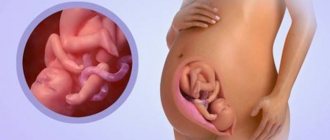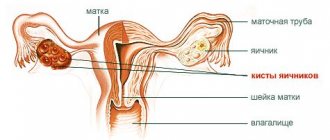You noticed that closer to the third trimester your feet were swollen, your fingers and ring could not be removed or put on. This indicates swelling.
Edema is one of the three main signs of gestosis (also known as late toxicosis). It usually manifests itself in the third trimester, but individual development of the situation is also possible.
There are 4 degrees of severity of late gestosis.
The first, easiest, dropsy of pregnancy (“dropsy” is outdated, more common – “gestational edema”)
complaints of fatigue, malaise, symptoms: swelling, or pathological weight gain.
Second degree – nephropathy of pregnancy
(swelling + protein in urine + pressure). If all 3(!) signs are present, there is a threat to health. If not, treatment is symptomatic.
Third degree - preeclampsia
– nephropathy + symptoms from the fundus and brain.
Fourth degree – eclampsia (convulsions).
This threatens, first of all, with a transition to a more severe degree of late gestosis - one, “aging” of the placenta and fetal hypoxia - two.
It is very simple to distinguish the “wheat from the chaff”; you need to perform the McClure-Aldrich test, which consists of injecting 0.25 ml of saline solution intradermally (like Mantoux in childhood) and timing the resorption time of the papule. Normally, the resorption time of a papule is 35-45 minutes; if the resorption is delayed, it means that there is an excess of water in the body, and dropsy actually exists. Or a very simple option: press your finger on the skin, if the skin quickly evens out, then everything is fine, but if there is a hole left, then most likely it is swelling.
If only your legs swell, this is normal. As a rule, a lack of fluid and constant thirst occurs due to the increased need of the body. If not only your legs are swollen, but also your thighs, legs, and anterior abdominal wall, then run to the doctor. Remember, if left untreated, this can lead to disruption of the uteroplacental circulation and fetal hypoxia; in severe cases, pregnancy is even terminated for medical reasons.
Do not reduce your water consumption because... it can have the exact opposite effect. When you reduce fluid, the body will try to retain it, and swelling will increase accordingly. Drink at least 1.5 liters of water (just water!) per day; soups and fruits do not count. Try to raise your legs to the top more often. Try to stay in a hot place as little as possible. Try not to overuse salt and spices, as well as sweet and carbonated drinks, which inhibit the removal of fluid from the body. First of all, the doctor must determine the cause of the swelling.
We offer the following options for combating edema:
– do not limit the amount of water you drink; – anti-edema gel (eg AVENT); – cool water (feet in a basin for 20 minutes, and then raised above head level); – foot massage (rub well with a washcloth); – kidney tea and other herbal teas only on the recommendation of a doctor; – drink a glass of hot milk at night, one day a week on apples and juice and try brewing dried apricots at night, and first thing in the morning drink water from it and for the next 30-40 minutes do not eat or drink anything; – regular tea with lemon without sugar or just water with a slice of lemon; -lingonberry compote; – take off your wedding ring and don’t wear it again until the birth; -Diuretic tablets should not be used.
Source: www.baby.ru
Causes of swelling during pregnancy
Edema in pregnant women
most often occur in late gestation. This can be explained by insufficient adaptation of the female body to changes. A woman’s hormonal levels change, blood clotting increases, and the vascular wall transforms. After childbirth, the woman’s condition returns to normal and the swelling disappears. Despite this, it is better not to delay measures to improve the condition of the pregnant woman and prevent complications.
Before treating edema during pregnancy, doctors recommend a balanced diet: a normal salt and normal water diet, a sufficient amount of protein in the daily menu of a pregnant woman. In addition, the woman in labor must be under constant supervision of a specialist in order to take timely measurements, control blood pressure, and measure daily diuresis.
Therapeutic gymnastics helps improve the condition and quality of life of the expectant mother during pregnancy
The exercises in this complex are aimed at partially or completely
reducing edema during pregnancy.
| Olga Bolshakova - yoga and breathing coach, StopKilo expert |
Decongestant set of exercises
It's best to do it in the morning. It perfectly energizes and, which is important in this case for edema, accelerates the lymphatic system and the lymph flow itself. At the level of the circulatory system, processes also improve. When blood and lymph function normally, there can be no swelling. Unless the cause of the disorders is related to a specific disease.
Healthy eating and dieting
Every woman experiences swelling during pregnancy. How to relieve swelling of the legs, arms or face? A healthy diet will help with this. A pregnant woman should adhere to a balanced diet rich in animal proteins. For a diuretic effect, doctors recommend drinking herbal teas and juices and eating foods containing potassium, such as potatoes, apricots, soy and melon.
In case of swelling, first of all, it is necessary to exclude spicy and fried foods, canned food from the diet, and limit salt intake.
A salt-free diet showed good results during pregnancy. The essence of the diet is that you are allowed to eat in small portions. Dishes must be steamed. You can't salt anything. This diet should be followed for no more than 2 weeks, otherwise the water-salt balance in the body is disrupted. When on a salt-free diet, you can drink herbal infusions, green tea and juice. Fresh vegetables and fruits are considered healthy.
If you have swelling during pregnancy, you can follow a protein diet. Its principle is that for every 1 kg there are 120-150 g of easily digestible proteins. A pregnant woman can eat chicken, rabbit, fish, cheese and dairy products. All sweets must be excluded from the diet. This diet is not recommended if you are allergic to dairy products.
It is also undesirable to follow the diet for more than 2 weeks, because it can increase cholesterol levels in the blood and lead to kidney dysfunction.
If your legs swell during pregnancy, doctors recommend drinking carrot, beetroot, apple or pumpkin juice. They, like herbal decoctions of hawthorn and caraway, have a diuretic effect. Rice and curd days help to cope with swelling of the feet. On such days you are allowed to drink kefir or yogurt.
If your legs swell significantly during pregnancy, then you should exclude sweets, fatty foods and flour baked goods from your diet. Dairy products, honey, chocolate, sweets and syrup are prohibited. You need to forget about sausages and bacon for a while.
Artificial additives, mayonnaise, cheeses, cakes and sauces can cause swelling in the legs. These products can be replaced with fresh vegetables, herbs and fruits. You can also give preference to legumes, cereals, rice, oatmeal, nuts, fish and freshly squeezed juices.
Special exercises for pregnant women against edema
Exercise 1
Place your feet so that when you squat, your knees are directly above your heels. Strive to open your knees to the sides. Do not squeeze your pelvis, but on the contrary, try to feel how your hip joints open. If you haven't exercised before, don't squat deeply.
At the bottom: In the final position, hold for three breaths, taking deep breaths and three deep exhales. Then climb back up.
Photo: Tatyana Pavlovskaya, trainer, StopKilo expert
Exercise 2
Place your feet so that when you bend, your knee is directly above your heel and does not form an acute angle. If you haven’t worked out for a long time, don’t go deep into the position. As you inhale, rise up. As you exhale, bend your right knee and tilt your body down, keeping your back straight. Constantly monitor the position of your straight spine. Breathe through your nose. Inhale up, exhale to the right, inhale up, exhale to the left.
Photo: Tatyana Pavlovskaya, trainer, StopKilo expert
Exercise 3
At the moment of bending, the knee should be strictly above the heel. Back foot on toe. Constantly push the heel of your back leg back, taking the load off the front of your thigh. Keep your back straight. You can not raise your arms completely up: keep them parallel to the floor or bring them to a comfortable level.
Option for beginners - palms lie on the thigh. As you inhale, arms up, as you exhale, back to your thigh. Maintain a static shape in your legs.
Photo: Tatyana Pavlovskaya, trainer, StopKilo expert
Exercise 4
Place your feet hip-width apart and point your toes straight forward. Keep your back absolutely straight. Hands shoulder width apart. Be sure to relax your shoulders. Feel the tension throughout your body: from your heels to your toes. Try to create uniform tension throughout the muscles of the body. Don't strain any one part of your body more than others.
Photo: Tatyana Pavlovskaya, trainer, StopKilo expert
Exercise 5
Place your feet slightly wider than hip-width apart. Keep your arms down on both sides of your body. Socks straight forward. Make a movement in which it is as if you are sitting on a chair. At the same time, extend your arms in front of you: interlace them in a lock or bring your palms together at chest level. Press your fingertips against each other.
Keep your back absolutely straight. Distribute the load evenly throughout the muscles of the body. Push your tailbone back slightly, lengthening the line of your spine.
Photo: Tatyana Pavlovskaya, trainer, StopKilo expert
Source: stopkilo.net
Basic principles of gymnastics for edema in pregnant women
Before starting a set of physical exercises, if a woman has not previously exercised, it is necessary to consult a doctor.
- Exercises should not cause discomfort or pain, otherwise they must be stopped.
- Exercises should be performed at a leisurely pace, carefully with a gradual increase in duration.
- It is optimal to carry out decongestant exercises in the morning, as it activates lymph flow and blood flow and energizes you.
Rules for organizing exercises against edema during pregnancy
It is difficult to underestimate the importance of physical activity and gymnastics during pregnancy. Correctly performed exercises against edema during pregnancy help relieve tension from the spine and normalize pressure on internal organs.
Exercises for pregnant women against edema will prepare the body for the upcoming birth and facilitate the work of the heart muscle and lungs.
Gymnastics for pregnant women, performed according to the rules in compliance with all recommendations, will provide the mother and fetus with the necessary oxygen.
Recommendations and tips for preparation:
- You must first undergo an examination and consultation with a gynecologist.
- It is recommended to start performing exercises against tumors of the limbs or other parts of the body under the supervision of an experienced trainer to ensure the safety of mother and child.
- Physical exercises during pregnancy to relieve swelling should be carried out gradually increasing the load so that the beginning is not stressful for the body.
- Each trimester and individual characteristics of pregnancy require its own set of measures.
- Depending on the individual nuances of a woman’s body, when choosing loads, it is important to take into account contraindications.
- On average, you should do gymnastics for no more than 1 hour per day.
- Be sure to control your breathing, follow a regimen of exercise and rest.
Important! If during exercises during pregnancy you feel unwell, dizzy, or start bleeding, you should immediately consult a doctor.
Causes of edema
Edema is one of the most common conditions during pregnancy, in which excess fluid accumulates in the tissues. After conception, the volume of blood circulating in a woman’s body increases, its reserves are deposited, creating swelling in certain areas of the body. Also, sodium accumulates in the vessels and soft tissues of pregnant women, which by its nature has the property of attracting and retaining water.
Such changes in the body after fertilization of the egg lead to the development of physiological edema, which does not pose a danger to the fetus and does not require treatment. The following factors can provoke the appearance of physiological swelling:
- genetic predisposition;
- eating salty foods;
- physical stress;
- hot weather conditions.
Most often, physiological edema is observed after 4 months of gestation. Pathological causes of edema during pregnancy include:
- Varicose veins of the legs. As the child grows, the size of the uterus also increases; it begins to compress large arteries, disrupting the outflow of blood from the lower extremities.
- Improper functioning of the kidneys. During the entire gestational period, the kidneys are subject to a double load, which they cannot fully cope with.
- Dropsy of pregnancy. A dangerous complication during pregnancy, in which severe swelling is accompanied by a noticeable increase in body weight.
- Late gestosis. This form of toxicosis develops in the later stages of the gestational period and poses a serious threat to the health of the baby.
If during pregnancy only one leg swells, the reason for this may be compression of the iliac vein by the enlarged uterus, resulting in stagnation of blood on one side. Sometimes severe swelling in pregnant women is a sign of cardiovascular pathologies (thrombosis, heart failure), metabolic disorders or allergic reactions.
Special exercises for pregnant women against edema
By themselves, exercises for pregnant women will not get rid of edema immediately; a full range of measures is necessary to eliminate swelling. Physical activity helps reduce swelling if it is not caused by internal diseases of the pregnant woman.
Exercises for pregnant women against edema include the following:
- Sit comfortably, straighten your legs, place your hands on the floor and make circular movements with your feet. For 1-2 minutes clockwise and counterclockwise. To prevent cramps, it is necessary to pull the toe toward you as much as possible.
- Stand, spread your legs at a distance of 10 cm, put your hands on your waist and roll from heel to toe. Effectively perform the movements for 2-3 minutes.
Important! When doing exercises during pregnancy to relieve swelling at home, you need to get rid of constricting, uncomfortable clothes that will get in the way.
- Get on all fours and alternately lift your left and right legs. Completion time: no more than 10 minutes.
- Lie on your back, on a flat surface, place your arms along your body, lift each leg alternately, fixing them in the upper position for 1 second.
- Simple gymnastic movements - lie on your back and stretch your toes and heels forward. After 10 times for each leg, alternately pull each leg, bent at the knee, towards the stomach. Perform at least 10 times for each leg.
Important! It is recommended, if possible, to carry out all movements in a lying position, this reduces pressure and stress on the uterus. After each complex, take a break, because the uterus puts pressure on the vena cava and dizziness may occur.
- Get on all fours, arch your back and take a deep breath. Lower your tummy, straighten your shoulders and raise your head. As you exhale, stretch your chin down and lift your back up. Perform this activity 10 times.
Sports activities are designed to relieve swelling, they bring a feeling of comfort and calm, help relieve stress, and add confidence. It is important that they help maintain good muscle tone and prevent the appearance of stretch marks and tumors.
Massage and baths for leg swelling during pregnancy
Cool water baths are a good way to relieve swelling during pregnancy. The water temperature should not be too cold: 22-23 degrees; If you add a pre-brewed relaxing herbal mixture to such a bath, you can achieve an even greater effect.
After performing the bath, you need to lie down and rest a little on your side, raising your legs or putting them on a pillow, and then do a light massage of your feet with smooth rubbing, circular movements. Proper massage will improve blood circulation and help veins cope with stagnation.
Alternative sports activities
If the pregnancy is progressing well and there are no contraindications, a woman can choose any possible option for physical activity:
- Yoga helps to improve the well-being of pregnant women and teach proper breathing. However, there are asanas that are not recommended for performance; they must be designated by a master trainer.
- Fitball is aimed at improving the functioning of the cardiovascular system, increasing muscle flexibility and elasticity, reducing swelling and back pain. Exercises using a large plastic ball improve blood flow, improve your mood and overall well-being.
- Pilates is one of the optimal complexes for pregnant women, which develops and strengthens the pelvic muscles, preparing them for childbirth. Special movements help improve blood circulation and supply the fetus with blood and oxygen.
What are the dangers of edema during pregnancy?
Physiological swelling during pregnancy, which occurs as a result of exposure to certain factors (salty foods, physical activity), does not pose a danger to the mother and her child and does not require treatment. However, some doctors, even with such edema, recommend therapy, preventing the occurrence of such a dangerous condition as gestosis - late toxicosis, accompanied by increased blood pressure and proteinuria. At an advanced stage of gestosis, preeclampsia develops, which can lead to the death of the child and mother.
Also, as a result of swelling during the gestation period, the body does not receive enough oxygen, which can cause fetal hypoxia. In case of severe swelling, which threatens severe complications, doctors recommend terminating the pregnancy.
Prevention
Moderate systematic exercises for pregnant women against edema not only help reduce swelling, but also help prevent it:
- Swimming is a great sport for pregnant women. Exercises in water and swimming in the pool help relieve tension from the spine and strengthen the muscles of the back and pelvis. Exercise prevents stretch marks from appearing. It is recommended to visit the pool 2 times a week. It is possible to sign up for equa aerobics.
- Walking at a brisk pace helps a woman keep herself in good shape. They must be performed every day, in comfortable shoes and clothes. It is recommended to keep your back straight, close your mouth and breathe through your nose slowly. Such simple measures significantly improve blood circulation and eliminate swelling. Walking improves your mood and promotes sleep.
- Massage. If there are no contraindications, you can visit the massage room and do relaxing exercises. A specially developed complex of massage manipulations for pregnant women stimulates blood flow to the fetus, improves blood circulation in tissues and eliminates swelling.
Gymnastics for pregnant women: the most important exercises
Type of exercise Description of the exercise Pelvic rotation One of the most important exercises for a pregnant woman; to perform it, you need a fitball or, in the absence of one, you can use a chair or pouf. You need to sit straight, keeping your feet shoulder-width apart, and perform rotational movements with your pelvis to the right and left. When performing the exercise, the stomach and back should be relaxed, hands can be kept on the stomach. Repeat the exercise 10 times. Spinal stretch To perform this exercise, you need to sit straight on the floor with your legs in the “Turkish” position. Holding your ankles with your hands, you need to bend, rounding your back, then, having reached the maximum, freeze in the final position for a few seconds, then relax, return to the starting position and repeat a dozen times. Side bends while sitting Having taken the starting position as for the previous exercise, you need to lower your arms along your body, touching your fingers to the floor. Inhaling, you need to raise one arm vertically up, while simultaneously leaning in the opposite direction. The elbow of the second hand should be aimed at the floor. This is an effective side torso stretch and should be repeated at least 6 times on each side. Circles with your feet You need to lie on the floor with your knees bent. Place the shin of one leg on the knee of the other, and in this position, rotate the foot in both directions. This exercise improves blood circulation, reduces blood stagnation in the legs, and improves the tone of the calf muscle. Each foot must be rotated at least 10 times. Prevention of flat feet Starting position as in the first exercise: sitting straight on a fitball, chair or pouf with feet shoulder-width apart. Raise one leg and rest the arch of the foot on the shin of the other leg, moving along the calf muscle. Several times will be enough for your legs to feel more comfortable and not hurt so much due to the heavy load.
These are the most important exercises that a pregnant woman should not ignore in the third semester. They should be performed every day (of course, if there are no contraindications), and then you can confidently look forward to the day of birth.
By following simple recommendations, you can prepare yourself for childbirth and not fear negative consequences.
Contraindications to performing gymnastics for pregnant women for edema
There are a number of restrictions on physical activity that women should not perform during pregnancy:
- Cycling;
- Horseback riding;
- Step aerobics;
- Skis, skates.
In order to maintain pregnancy and not harm the development of the fetus, you should refuse any exercises that are prescribed to be performed at a fast pace, with sudden movements, somersaults and bends.
Gymnastics for pregnant women against edema are developed depending on the severity of the cause that caused the swelling, indications and well-being. You should first consult a doctor and undergo the necessary tests. It is very important to notice the problem in time and not ignore the symptoms of edema.
Source: otekimed.ru
Localization of edema
The location of edema in pregnant women directly depends on the reasons that caused them. The skin becomes flabby and loose, creating a “cushion-like” feeling.
The main workers - the legs - are most susceptible to swelling. It’s difficult to put on your usual shoes, so many pregnant women switch to a larger size—I had to do the same, because my usual shoes became too small. Mom's sandals, which were just the right size, helped out. Beauty is no longer as important as comfort, so your husband’s shoes, especially winter ones (provided there is a slight difference in size), can also be a good option. Relief marks from the elastic bands of socks appear.
The hands and especially the fingers are often affected. They swell and it becomes extremely difficult to remove the ring and clench your fingers into a fist. At risk are women who work a lot and for a long time on the computer, doing various types of needlework. In this case, the so-called tunnel syndrome can be added to the swelling: fluid stagnates in the wrist and puts pressure on the wrist nerve, causing pain.
Swelling is usually more pronounced on the fingers; in more complex forms, it spreads to the palm and wrist
Swelling also appears on the face: the oval of the face itself becomes rounded, the eyelids, nose, and eyes swell. This may indicate kidney problems that should be treated.
The nasal mucosa is swollen. Vasomotor rhinitis, or simply rhinitis of pregnant women, is common among pregnant women. Swelling occurs due to changes in hormonal levels, breathing becomes difficult, and unpleasant sensations of itching and burning appear in the nose.
Attention! With rhinitis in pregnant women, fever and sore throat are never observed. If such symptoms are associated with nasal congestion, you should definitely consult your doctor.
Allergens also cause similar symptoms, so you need to analyze your environment and try to identify the cause.
Massive swelling of the abdominal wall and lower back is rare. They are observed in severe degrees of gestosis and are also accompanied by damage to the legs, arms, face and other parts of the body.
With pathological edema of different etiologies, not only their location differs, but also the appearance of the skin above the accumulation of fluid.
Table: localization and additional symptoms of edema depending on the type
| Type of edema | Localization | Additional symptoms |
| Cordial | Swelling appears on the legs and spreads upward. When standing, only the lower limbs swell. When lying down, the swelling spreads to the lower back. Goes away after rest. The skin is bluish and cold. The dent does not disappear for a long time. |
|
| Renal | Swelling spreads from top to bottom, usually appearing in the morning. The skin in the affected area is loose, pale, and dry. The dent caused by finger pressure quickly disappears. |
|
| For varicose veins | Swelling occurs against the background of severe fatigue of the legs with swelling of the veins and redness of the feet. Most often appear on one leg. The skin is warm. |
|
| With gestosis | The feet and ankles swell first; with more severe degrees, the damage spreads to the thighs, pubis, abdomen, and face. |
|
When to sound the alarm
Doctors distinguish 4 stages of edema in pregnant women:
- swelling of the lower legs;
- swelling of the lower body;
- the addition of swelling of the hands and face to the signs of the second stage;
- general swelling of the whole body.
By and large, at any of these stages it would be useful to consult a doctor who is observing you. However, the addition of swelling of the legs to swelling of the arms, face and other parts of the body should especially concern you. Inaction in this case is fraught with such a serious disease as gestosis, in which the function of the placenta is disrupted and the child ceases to receive the nutrients he needs.
There are also cases when swelling is hidden, i.e. They don’t show themselves outwardly. But they are no less dangerous, since fluid accumulates in the tissues and organs of the body. A rapid weight gain (up to 0.5 kg per week) with a simultaneous decrease in urine output will tell you about “hidden” edema.
Treatment of edema during pregnancy, depending on its severity, is carried out:
- or on an outpatient basis, which may include recommendations for a special diet with limited salt and sugar intake, the prescription of diuretics, drugs to improve uteroplacental blood flow and better supply the fetus with nutrients (Magne B6, Magnelis, Magnerot);
- or inpatient - then the pregnant woman will most likely be prescribed a series of droppers with magnesium, vitamins and other drugs to strengthen blood vessels.
Model in the photo – Natalya Grishko









